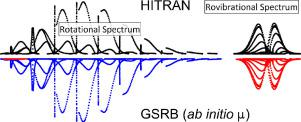Journal of Quantitative Spectroscopy and Radiative Transfer ( IF 2.3 ) Pub Date : 2020-06-24 , DOI: 10.1016/j.jqsrt.2020.107188 Stephen C. Ross , Koichi M.T. Yamada , Fumiyuki Ito

|
Considerable work has gone into identifying and delineating the effects of quantum monodromy on molecules. Recently this included consideration of transition intensities of the NCNCS molecule using ab initio electric dipole moment functions in the Generalised SemiRigid Bender (GSRB) model [M. Winnewisser et al. PCCP 16, 17373-17407 (2014)]. In that work a discrepancy between the observed and calculated spectra was discovered. The purpose of the present work is to identify the source of that discrepancy - is it due to the physics of monodromy itself or are other issues involved? To investigate this we use the same theoretical approach for the simpler molecule HOCl. This allows us to identify a programming error affecting the b-type rovibrational transitions. We show that the NCNCS spectrum calculated with the corrected GSRB model does reproduce the experimental spectrum for pure rotational transitions within the ν7 large amplitude bending vibrational states, starting from the ground state and progressing through levels at the monodromy energy and beyond, while also reproducing the a-type rovibrational spectrum. However, the discrepancy with regard to the b-type rovibrational transitions remains. We discuss possible reasons for this discrepancy. In the course of this work we obtain a good GSRB model for the bending vibration-rotation levels of the atmospherically important HOCl molecule and its isotopologues. With ab initio calculations of the electric dipole moment function the GSRB calculates the rotation and bending rovibrational spectrum of HOCl in agreement with other determinations and with experiment. Using the physically constrained GSRB model, errors in tabulated transitions (including in the HITRAN database) were easily identified.
中文翻译:

GSRB旋转和漫游强度用于:弯曲的HOCl分子,以及:NCNCS中的量子单峰
在鉴定和描述量子单峰对分子的影响方面已经进行了大量工作。最近,这包括在广义半刚性弯管机(GSRB)模型中使用从头算电偶极矩函数来考虑NCNCS分子的跃迁强度的方法。Winnewisser等。PCCP 16,17373-17407(2014)]。在这项工作中,发现了观察到的光谱和计算出的光谱之间的差异。当前工作的目的是确定差异的根源-是由于单峰本身的物理性质还是其他问题?为了对此进行研究,我们对较简单的分子HOCl使用相同的理论方法。这使我们能够确定影响b的编程错误。型旋转振动过渡。我们表明,与校正GSRB模型计算出的NCNCS光谱并重现该实验光谱内的纯转动跃迁ν 7大振幅弯曲振动状态,从接地状态开始,并通过在单值能量和超越水平进展的同时,也再生在一个型振动频谱。然而,关于b型旋转振动的转变仍然存在。我们讨论了这种差异的可能原因。在这项工作的过程中,我们获得了大气上重要的HOCl分子及其同同位素的弯曲振动-旋转水平的良好GSRB模型。随着从头电偶极矩函数的计算中GSRB计算旋转,并与其他测定,并与实验弯曲次氯酸振转光谱一致。使用受物理约束的GSRB模型,可以轻松地识别列表转换中的错误(包括HITRAN数据库中的错误)。











































 京公网安备 11010802027423号
京公网安备 11010802027423号